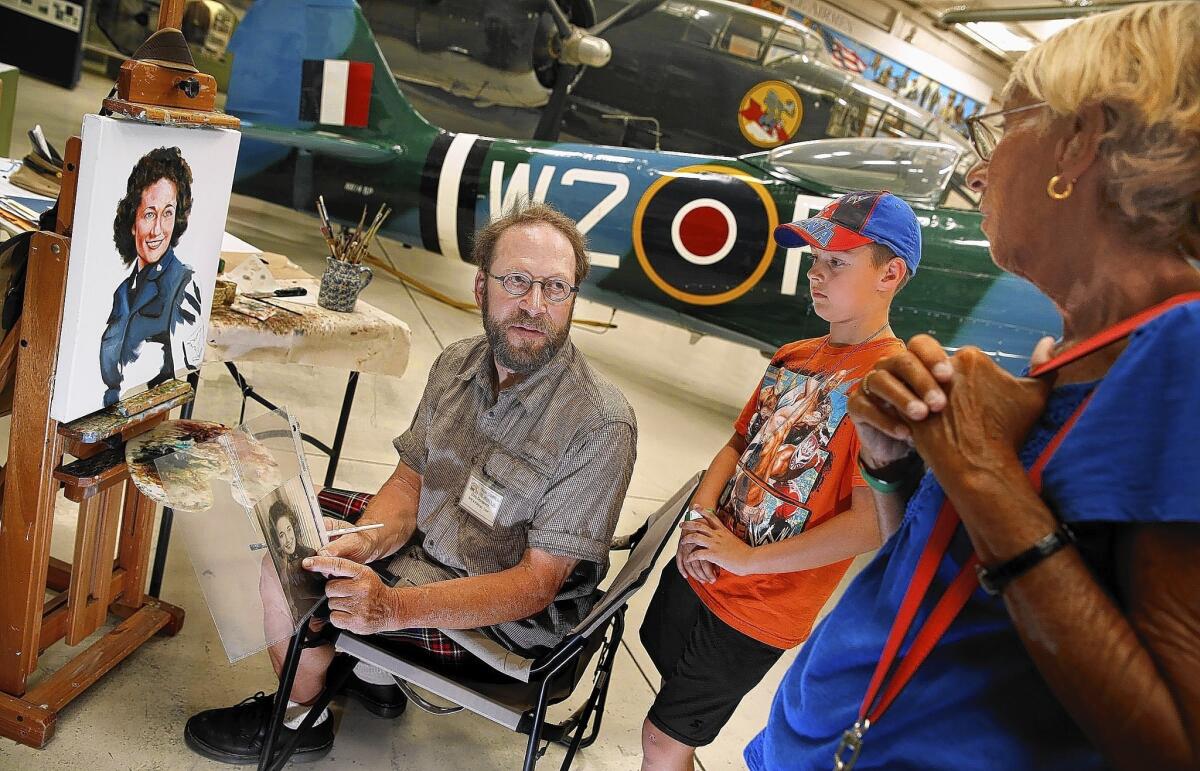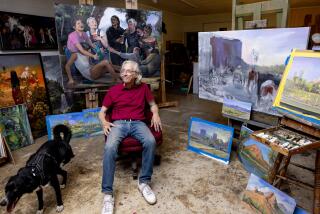Great Read: Painter takes WWII vets back in time with traveling portrait exhibit

Portrait artist Chris Demarest pauses to talk with Palm Springs Air Museum visitors Lenore Crilly of Sierra Madre and grandson Ethan Jordan, 9, of Glendora.
- Share via
Reporting from Palm Springs — Inside an air-conditioned hangar in the Sonoran Desert, a man in a red and black kilt sat in the shadow of a Supermarine Spitfire and painted.
Midmorning, visitors to the Palm Springs Air Museum shuffled past shined-up war relics, peering into cockpits or getting lost staring across the big, bright box of a room. Distracted by wings or tail fins, they tended not to notice Chris Demarest until they nearly bumped into him and his long table of paint vials, water jugs and solvent cans.
He looked into his canvas, very closely. A small, folded, black-and-white photocopy of a portrait sat next to him. As he glanced over at it, he painted light brown streaks that would form the beginning of a face. He had a steady hand.
Behind him was an entire wall of portraits — young servicemen and women in coveralls or pilot uniforms, leaning against planes, embracing or hard at work.
He’s painted all 70 of them.
As Demarest talked about his work, a docent stopped to join him.
“This — this is really important,” the man said.
For the last two years, Demarest has wound across the country from library to museum to retirement home, displaying his intimate portraits of World War II veterans in their prime, and preparing new works from the people he meets along the way.
Veterans and their families circulate through the big room, stopping to chat. They bring him black-and-white photos, photocopied portraits or plastic scrapbooks to share. These little frozen-frame moments, for many, contain the biggest stories of their lives.
“They all still think of themselves as being 18 or 19 years old,” Demarest said.
He can’t do all the veterans’ portraits, but he takes as many of their offerings as he can handle and reconstructs them in full color on canvas. Each of his portraits is accompanied by a neat, typewritten story beneath it.
Some of the subjects are famous — like Hazel Ying Lee, one of the first Chinese American female pilots — but most are not. They are the anonymous faces of war — men swept up from small towns or women working the home-front factories.
Men like George Edwards, a 94-year-old veteran who knows what it means to fight.
::
Sometimes it takes grit, like the battle in Italy that fractured his spine. Sometimes it takes discipline, like the march across the Arizona desert in training camp.
And sometimes it takes creativity, like some well-placed roofing nails in a hand-to-hand fight.
Edwards learned these lessons quickly as a black man in a country, an army and a time that made him fight for nearly everything.
As an officer of the 92nd Infantry Division, the Buffalo Soldiers of World War II, Edwards led platoons through Italy — the Alps, the Apennines and the Po Valley. His Purple Heart was pinned to his baseball cap as he sat in the library of the Air Museum and remembered.
In some ways, combat was an escape from home for Edwards and the men of the 92nd. Italy was a place where even the countesses spoke to soldiers, where GIs congratulated themselves on saving the pope, and where people remembered the story of Hannibal and his African troops coming down from the mountains.
Edwards gestured to Demarest’s portrait propped up next to him. He is young, lithe, natty in his uniform. His wife, her hair up, leans into him.
“Coming from slavery to freedom, you’ve got to fight for things,” he said. “The biggest thing is you’ve got to demand respect.”
::
For most of his career, Demarest, who at 63 has a friendly chuckle and a trim beard, was a children’s book author and illustrator, and then an official artist with the Coast Guard. A few years ago, after illustrating best-sellers and embedding with rescue swimmers and helicopter pilots, Demarest saw book sales start to go soft.
Around that time, he painted his first portrait of a World War II veteran — the father of a neighbor. The portrait was adapted from a black-and-white photo in which the man, 19 at the time, casually leans against the wing of his plane. Demarest saw echoes of his own dad — a wartime pilot himself — and painted the portrait for the man’s 88th birthday.
“My neighbor said, ‘My dad, I’ve never seen him cry before, but when I gave him that painting, he teared up,’” Demarest said.
With that, he knew he had his next subject.
A divorced dad with a son in college, he took the project on the road. He sold his house in New Hampshire and all his furniture. For the last two years, he has funded his exhibits out of his own pocket with only the occasional small stipend from a museum or library.
It was the perfect time, he said, to travel the country.
“People ask me where I live, and I point to the parking lot,” Demarest said. He’s slept nights in Joshua Tree National Park and small-town motels. Lately a docent has let him use a spare room in her house.
He networks with museum administrators and foundations, but often finds his project a hard sell. He’s still searching for future venues.
Sharon Sharry, who directs the Massachusetts library where Demarest had his first show, says his work increased patronage.
“Almost all of us have been touched by war. That was one of the reasons he was so popular. We all have something in common and something to discuss with Chris,” she said.
Demarest knows he has limited time to engage with his subjects. With the 70th anniversary of the end of World War II approaching and with most of the war’s veterans in their last years, he’s eager to continue his exhibit. Maybe the heartland, maybe Hawaii, but the project will continue, he said.
“When I started this, I called it a tour,” he said. “Now I call it a journey.”
For many of the veterans, he’s one of the few people they will ever open up to about the war.
World War II soldiers come from a generation in which postwar therapy often amounted to two weeks decompressing on a troop ship back from the front lines, then a lifetime of silence, he explained.
“The artwork is a conduit to stories. It’s a safety net,” he said. As he talks to his subjects, he scratches down notes. Sometimes his conversations can run for hours. One man admitted that he had told Demarest more than he had told his wife.
He remembers his own father’s relationship with the war. He never talked about it, until the end.
“He was sleeping most of the time. He woke up at one point and said, ‘You know, I was just back in flight school. If this is what dying is, I don’t mind.’ ”
::
Even with all his success on the battlefield, some fights George Edwards just couldn’t win.
Gazing longer at Demarest’s portrait, Edwards didn’t talk about himself. He looked only at his wife.
“This means a hell of a lot,” he said. “She’s been dead 62 years.”
Complications from a blood disorder led to her death during childbirth. The following year, doctors began prescribing a treatment that might have saved her.
“She missed it by one year,” he said. Never remarried, he raised four daughters and a son — who died at age 12 — by himself.
Demarest remembers giving Edwards the painting. The stoic soldier put his head in his hands and cried. Even today, Edwards sees his reflection in the canvas.
“It’s my whole damn life. It’s my whole history. You see how young I was?”
Edwards refocuses on the paint, and his eyes brighten. He’s 25 again, on the front lines, ready for a fight.
Twitter: @mtthnsn
More to Read
Sign up for Essential California
The most important California stories and recommendations in your inbox every morning.
You may occasionally receive promotional content from the Los Angeles Times.










